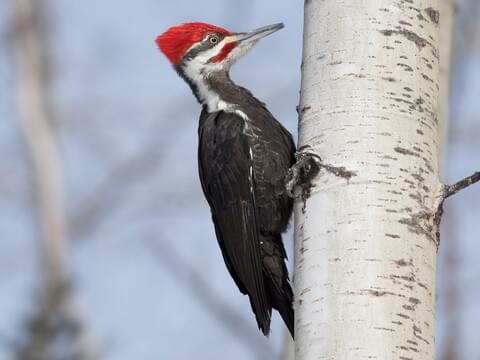Unveiling the Secrets of Woodpeckers: Behavior, Environment, and Much More
Woodpeckers, with their one-of-a-kind actions and specialized adjustments, have lengthy amazed scientists and nature lovers alike. These impressive birds possess a series of intriguing keys that shed light on their survival methods, environment choices, and elaborate communication techniques. By revealing the enigmas surrounding woodpeckers' habits and environment selections, a much deeper understanding of these bird marvels emerges, providing a peek right into their remarkable globe. So, what makes these birds truly outstanding, and just how do they browse their environment with such precision and skill? Let's check out the fascinating realm of woodpeckers and decipher the enigmatic details that make them such interesting subjects of research study.
Woodpecker Actions Insights
In taking a look at woodpecker habits, an interesting screen of specialized skills and adjustments arises, clarifying their remarkable eco-friendly particular niche - Woodpeckers in Florida. Woodpeckers, understood for their distinctive drumming on trees, have a selection of behavioral traits that add to their survival and success in their atmosphere. One essential behavior is their drumming, which offers several objectives such as interaction, establishing region, drawing in mates, and situating food sources. This rhythmic pecking likewise showcases their amazing toughness and endurance, as they can hammer away constantly at broadband without creating harm to themselves.
Furthermore, woodpeckers show an unique feeding habits identified by their capacity to extract pests from tree bark utilizing their specialized beaks. Their lengthy, barbed tongues help in recording victim, while their strong neck muscular tissues offer security and accuracy during pecking movements. This feeding technique permits woodpeckers to access concealed insect larvae and remove them with remarkable effectiveness.
Environment Preferences and Selection
What aspects affect the habitat preferences and choice of woodpeckers? Woodpeckers are very versatile birds known to occupy numerous settings worldwide. However, they do exhibit preferences for particular environment characteristics. One essential aspect affecting woodpecker environment option is the availability of appropriate nesting sites. Woodpeckers normally favor woodlands with a mix of fully grown trees that provide ample opportunities for tooth cavity excavation. These tooth cavities serve as vital nesting and roosting websites for woodpeckers and are crucial for their breeding success.
Additionally, woodpeckers reveal a choice for habitats with an abundant supply of food resources. They are largely insectivorous, preying on beetles, ants, larvae, and various other bugs discovered in decaying timber or tree bark. Consequently, woodpeckers often tend to favor wooded locations with a varied insect population to fulfill their nutritional requirements.
Additionally, the presence of dead or worn out trees is one more essential factor in woodpecker environment selection. These trees not just supply food sources yet likewise offer appropriate substrate go to my site for dental caries excavation. Dead trees are vital for the maintenance of healthy and balanced woodpecker populations, as they play an essential function in the woodpeckers' life process and environment dynamics.
Feeding Behaviors and Diet Plan Make-up
Woodpeckers demonstrate a specialized feeding actions focused on foraging for pests within different environments. Their diet largely includes pests such as beetles, ants, caterpillars, and crawlers, which they situate by tapping on tree bark and paying attention for the sound of activity inside. Woodpeckers use their strong beaks to pierce into the wood and their lengthy, barbed tongues to extract victim from holes. Along with insects, woodpeckers also take in tree sap, fruits, nuts, and seeds, including range to their diet regimen depending on the season and schedule of food sources.
The foraging strategies of woodpeckers are well-adapted to their arboreal lifestyle (Woodpeckers in Florida). Their ability to excavate timber not just provides them with food however additionally aids in continue reading this creating nesting tooth cavities and establishing areas. Woodpeckers play an important function in preserving the health and wellness of forests by controlling insect populations and aiding in the decomposition of timber. Recognizing their feeding behaviors and diet regimen make-up is necessary for preservation efforts focused on preserving these unique and beneficial birds.
Drumming Seems and Communication
Utilizing quick drumming noises on various surface areas, woodpeckers use an unique kind of communication to signal region limits and attract friends. This drumming habits is not just a way of communication however likewise offers as a method for woodpeckers to establish their visibility within a specific location. The strength, speed, and pattern of the drumming can communicate essential details to other woodpeckers in the location.
Woodpeckers utilize drumming sounds to introduce their existence in a territory and to alert off potential burglars. The loud and repetitive nature of the drumming works as a clear signal to other woodpeckers that the location is already declared. This helps in minimizing conflicts and lessening physical battles between people.

Survival Adaptations and Specialized Anatomy

Conclusion
Finally, woodpeckers show special habits, such as drumming sounds for interaction, and have specialized anatomy for survival in their picked environments. Their feeding practices and diet make-up additionally demonstrate their flexibility to different environments. By recognizing these elements of woodpeckers, researchers and conservationists can much better safeguard and maintain these interesting birds and their communities.